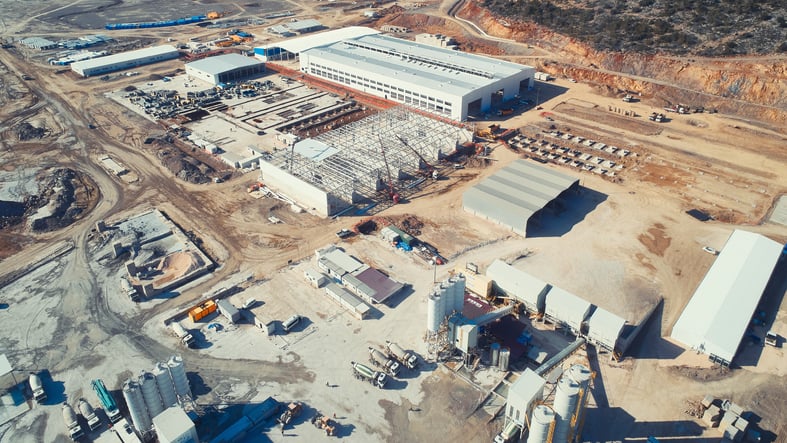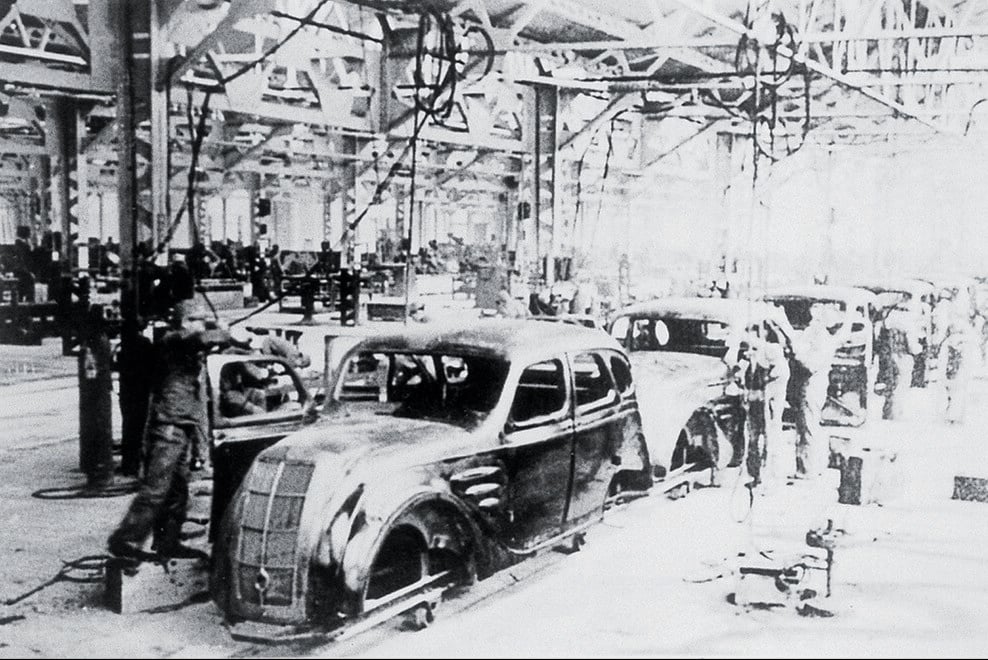
Picture a grocery store: Milk cartons, eggs, cheeses, fruits, vegetables, and other perishables sit on shelves. Stockboys add the newest deliveries, placed behind older goods to ensure they don’t spoil. Although, you might be hip to this practice and pull from the back of the shelf. Consider, too, the car dealership: It carries the SUV you fancy, but the color you prefer isn’t available on the lot and needs to be sourced from another dealer in a different city. Or maybe the transmission (if you’re like me and prefer to drive stick) isn’t available whatsoever and has to be custom ordered.
Do you ever wonder how grocery stores ensure they sell product through with minimal spoilage, how struggling automakers confront declining sales, or how the supply chains of the largest manufacturers—from consumer electronics and retail fashion merchandisers to restaurateurs—manage inventory to stay cash-flow positive? It all starts with a concept known as just-in-time, a production and inventory management system typically used in supply chain and logistics to perfect the manufacturing process. We’ll discuss that concept in this article and how construction inventory managers can use it to perfect tool room operations, eliminate construction downtime, and maximize productivity and profitability.
Jump Ahead:
What Is the Meaning of Just-In-Time Inventory?
Within inventory management, just-in-time is a philosophy that prioritizes minimizing inventory and maximizing efficiency (2).

According to the Institute for Manufacturing at the University of Cambridge (6), just-in-time is a “management philosophy" that “originally referred to the production of goods to meet customer demand exactly, in time, quality and quantity, whether the `customer' is the final purchaser of the product or another process further along the production line.”
In construction, it is defined within the International Research Journal of Engineering and Technology (7) as “a strategy for forwarding material or explicit labor or qualities at the exact second where it's required, reducing nearby inventories and inefficient worker hours.”
A Brief History of Just-in-Time Manufacturing
The Institute for Manufacturing at the University of Cambridge (6) traces just-in-time as a concept back to Japanese manufacturing organizations of the early 1970s, chiefly Toyota.

Pictured Above: TMHE’s Toyota History Part 2 – Model AA Sedan Production Line at the Koromo Plant. Image Source: Flickr
However, these concepts (and Toyota’s production system that is today iconic) harken back to much earlier — according to Toyota corporate, they go back to Taiichi Ohno, an industrial engineer and businessman whose career with Toyota began in 1943 as shop-floor supervisor in the engine manufacturing shop of the plant (and later Toyota executive).
Describing the Toyota Production System, Toyota's global website reads:
The Toyota Production System (TPS) was established based on two concepts: "jidoka" (which can be loosely translated as "automation with a human touch"), as when a problem occurs, the equipment stops immediately, preventing defective products from being produced; and the "Just-in-Time" concept, in which each process produces only what is needed for the next process in a continuous flow.
Source: Toyota Production System webpage
Ohno, according to Toyota corporate, established the Toyota Production System, and “built the foundation for the Toyota spirit of ‘making things’ by, for example, creating the basic framework for the Just-in-Time method.”
Ohno’s successors brought forth several automation innovations in the textile industry, including: a weft-breakage automatic stopping device (developed in 1896); the world’s first automatic loom with non-stop shuttle-change motion (aka: type-G Toyoda automatic loom, developed in 1924); implementation of chain conveyors into textile plant assembly lines (completed in 1927) that increased monthly production capacity; the same method applied to Toyota Motor Co’s production line in 1938; etc.
The Just-in-Time philosophy—described as “A production system based on the philosophy of achieving the complete elimination of all waste in pursuit of the most efficient methods”—has since been applied to Toyota’s automotive production lines and is rooted in the grounding manufacturing principle of “Making only ‘what is needed, when it is needed, and in the amount needed.’" The principle can be seen used in the supply chains of major auto manufacturers, including household EV manufacturers looking to battery and chip shortages.
What Is the Benefit of Just-in-Time Inventory?
Now that we’ve discussed the meaning of JIT, what is the benefit of just-in-time inventory? Some of the common just-in-time advantages witnessed across industries include:
- Reduced operational and labor costs
- Minimizing warehouse reliance, optimizing space used and cutting costs by reducing the overall storage capacity needed
- Reduced waste and increased production efficiency through lean management principles
- Continuous quality improvement
- A careful balance of safety stock reducing excess spending on raw materials – i.e., stock is sold through as needed and ordered as customer demand warrants
- Improved productivity
- Improved supplier relationships (i.e., relying on fewer suppliers, while being loyal to suppliers you retain)

What’s more, just-in-time inventory management has been implemented and its efficacy studied across a wide variety of industries:
- Within manufacturing and supply chain management, studies in the Journal of Operations Management (4) found JIT adoption reduced labor content (i.e., the amount of money your business spends on direct labor or the labor that's directly necessary to deliver your product or services.).
- In healthcare inventory management, JIT adoption studied in the Biomedical Journal of Scientific & Technical Research (9) “has proven [… to] save a lot of waste for the organization and provided affective savings for the organization.” Researchers writing for the Saudi Pharmaceutical Journal (1) observed benefits of JIT adoption including increased quality and efficiency; savings in healthcare resources; stabilized work schedule and increased productivity; cost reduction (in United State JIT has resulted in annual savings of approximately USD $3–11 million per hospital, which is around 10%–17% in savings); stock […being] “delivered by suppliers when needed, which reduces inventory costs by reducing unused inventory, freeing up money for HCOs to use for other care activities and care facilities;” minimized warehouse space, “thus reducing inventory holding costs and investment in stock;” other cost reductions [including] labor costs, reduced warehouse costs through automation; and improved productivity “as employees are able to focus on tasks related to patient care instead of unnecessarily handling inventory.”
- In construction inventory management, studies conducted for the International Research Journal of Engineering and Technology found JIT methods to exhibit the probability of extending productivity, quality, and organizational effectiveness (7). Studies have also been conducted into the efficacy of JIT in modular construction (5) and offsite construction (8). In offsite construction, authors (8) contend for contractors and manufacturers, JIT can offer a “dynamic and distributed solution” that can “reduce the time and storage waste resulted from underutilized resources in component delivery” of prefabricated building applications. In modular construction applications, researchers have provided a substantial literature review to practitioners looking to understand how they might implement JIT in modular integrated construction applications (5).
Disadvantages of Just-in-Time
Because JIT involves removing waste in the production process and relying on fewer suppliers to cut down on construction overhead, it requires dynamic inventory managers ready to respond to potential supply chain disruptions.

That said, some of the disadvantages of JIT inventory systems might include:
- Increased complexity in planning
- Potential disruptions in the supply chain
- Reliance on fewer suppliers could lead to construction downtime if supplier experiences an unexpected breakdown
- Potential compromise in quality if supply chain issues lead to sourcing materials from non-preferred vendor, while unexpected costs may also be incurred
In construction, for example, disadvantages of just-in-time inventory practices if not facilitated and refined dynamically could include:
All this to say, studies (5, 7, 8) show that having an understanding of critical risk factors and a dynamic approach to JIT implementation can ultimately lead to reduced cost, minimized waste, and greater outcomes overall particularly useful in construction projects where sudden changes in scope are commonplace.
Just-in-Time Inventory Examples
Now, we’ve discussed what just-in-time inventory is, as well as its advantages and disadvantages.
What are some prominent just-in-time-inventory examples where notable companies have found success employing these management philosophies?

Here are 10 just-in-time inventory examples at notable companies:
- Ford – Although Toyota is known to have popularized JIT principles, it’s believed that Taichi Ohno credited Henry Ford as the originator of the concept, particularly in relation to the Model T, which became wildly popular and required Ford to streamline assembly line production to meet customer demand.
- Toyota – As we’ve discussed above, Toyota’s Production System (TPS) is often cited as the foundation of JIT principles, particularly within the automotive industry.
- McDonald’s – The Harvard Business Review cites a “pull system” at work in McDonald’s locations to deliver orders to customers in real time to meet demand, ensuring the quality and freshness of ingredients, and reducing excess inventory. This pull system, methodically designed and portrayed in the 2016 docudrama The Founder, exhibits a carefully laid out kitchen to reduce foot traffic and optimize space for a choreographed dance where orders are received, prepared, and delivered to customers with rapid-fire speed and precision and absolutely no waste – this early depiction of the first McDonald’s location even skirts the need for silverware by allowing customers to eat their hamburgers right out of the sleeves they come in.
- Apple – We’ve previously discussed the inventory strategies that are employed by Apple in their supply chain, particularly how Tim Cook’s radical streamlining of Apple’s supplier relations and approach to inventory management and stocking helped save the company go from the brink of bankruptcy to becoming among the most valuable brands with a market cap exceeding $2trillion.
- Dell – In a story syndicated by the Chicago Tribune in 2002, reporter Crayton Harrison writing for The Dallas Morning News describes how Dell in those early days championed the buy-direct business that specifically gave customers what they wanted, as they requested it. Today, while Dell still manufacturers notebook computers (however, to a much lesser extent), it has shifted its business to offer a diversified selection of technologies for which it is an industry leader (e.g., field services, AI infrastructure, cloud IT infrastructure, servers, enterprise storage, etc.), showing the company’s foresight and dynamic flexibility as market conditions rapidly change.
- Zara – Zara, Intuit reports, keeps production in-house and reserves 85% of their capacity for in-season adjustments to give themselves flexibility and allowing them to release new products (and their variety of products) with greater frequency while maintaining quality and manufacturing steadiness/reliability. They also reportedly commit six months in advance to only 15 to 25% of a season’s line, and only lock in 50 to 60% of their line by the start of the season, which means that up to 50% of their clothes are designed and manufactured in the middle of the season. This operational flexibility removes the rigidity other manufacturers may experience that make them slow to respond to change.
- Amazon – Amazon has an extensive network of warehouses and a distribution and fulfillment centers that make its pull system second-to-none, what allows for barely any waiting. In Whole Foods, the company has implemented JIT, making its processes leaner and freeing up physical space.
- Intel – Well-known chip manufacturer Intel began implementing technology into its supply chain in 2005, which has resulted in an 11% reduction in inventory investment while total demand was satisfied on time more than 90% of the time, Supply Chain Dive reports.
- Boeing – The jumbo jet maker reportedly adopted the lean six sigma process in 1993 in response to fierce competition from Airbus. The result of these changes included improving production times by 60%, increasing floor space by 50%, and improving resource productivity by 30-70%.
- Harley-Davidson – Although the big twin manufacturer has faced recent headwinds, the company originally implemented JIT in its assembly lines in response to fierce competition from Japanese imports. The company as a result experienced spectacular growth through the 1990s and early 2000s.
How to Implement Just-in-Time Inventory in Construction
Experts agree that JIT has a place in construction, an industry known for sudden changes where proper inventory management is critical—but successful implementation of JIT philosophies in a construction supply chain is one that takes a dynamic approach (5, 7, 8).

Examples of a successful JIT implementation is one where technology is adopted to add real-time visibility and a dynamic management approach is used in conjunction with this technology:
- Cloud-based inventory system – A cloud-based inventory facilitates your team’s ability to collaborate in real time, increases transparency to real events (and facilitates the team’s ability to dynamically react to them), and reduces information silos and versioning nightmares. What’s more, pairing your inventory with other critical systems like project management and design helps in creating an organization-wide “digital twin” that will help you predict problem areas and respond to them proactively.
- Proper pull system – Establishing a streamlined “pull” system through software features like “kitting” and physical tracking products (e.g., asset tagging, Bluetooth tags, GPS trackers, etc.) help blend the physical and digital realms and facilitate a more dynamic tracking experience from crib to job and back. e.g., a crib pull system could look like this:
- Group all your items (perhaps in a PACKOUT or job box) you’re sending to the job in bulk
- Add individual trackers to these items (if not One-Key compatible) to add dynamic tracking for individual items as they are taken out of the kit. We recommend our ONE-KEY™ Bluetooth® Tracking Tag – item not in the kit list (see below) at the end of the day? You can ring its onboard speaker to find it nearby
- Add a standard kit tracker or barcode for easier auditing — when the kit’s barcode is scanned, you’ll get a list of everything that’s assigned to this kit which can be used as a check-list
- Adopt Antifragility Business Model – Robert LaCosse and I recently discussed what an antifragility business model is, and how it can be used in construction to weather unexpected change (to become, in fact, stronger through it). In summation: Building flexibility into your supply chain and empowering your workers to have the authority to respond dynamically to change are two essential ingredients to a JIT implementation.
- Industrialized Construction: Adopting an industrialized construction methodology to reduce waste through a variety of IC levers (e.g., prefab construction and modular construction to streamline preassembly; additive manufacturing methods like 3D printing to increase design freedom, speed, and reduce waste; construction robots to automate procedural tasks while keeping workers safer; building information modeling to fully leverage digital fabrication, increase collaboration, and mitigate risks; etc.).
Related Content: Read how our end users are using ONE-KEY™ inventory and PACKOUT™ modular storage together.
Bottom Line
The construction industry, rife with unexpected change and rescopes, is a tailor-made industry for adopting the just-in-time (JIT) inventory philosophy. This philosophy will empower tool room managers to more dynamically respond to change orders – and equipped with these tools, you can dynamically assess statuses of one project to another and make transfers without running the risk of increased downtime. Simultaneously, you can cut down on hoarding and costs associated with sudden change.
References
- Balkhi, B, Alshahrani, A, and Khanc, A. (2022, 11). Just-in-time approach in healthcare inventory management: Does it really work? Saudi Pharmaceutical Journal 30(12), 1830-1835, https://doi.org/10.1016%2Fj.jsps.2022.10.013
- Banton, C. (2023, 03). Just-in-Time (JIT): Definition, example, and pros & cons. Investopedia. https://www.investopedia.com/terms/j/jit.asp
- Dakhli, Z. and Lafhaj, Z. (2018, 03). Considering materials management in construction: An exploratory study. Logistics 2(1), 7 https://doi.org/10.3390/logistics2010007
- Huson, M. and Nanda, D. (1995, 06). The impact of just-in-time manufacturing on firm performance in the US. Journal of Operations Management 12(3-4), 297-310, https://doi.org/10.1016/0272-6963(95)00011-G
- Hussein, M and Zayed, T. (2021, 02). Critical factors for successful implementation of just-in-time concept in modular integrated construction: A systematic review and meta-analysis. Journal of Clearer Production 284, https://doi.org/10.1016%2Fj.jclepro.2020.124716
- Institute for Manufacturing. (n.d.). JIT Just-In-Time manufacturing. University of Cambridge. https://www.ifm.eng.cam.ac.uk/research/dstools/jit-just-in-time-manufacturing/
- Patel, V and Solank, J. (2020, 06). Just in time concept used in construction project. International Research Journal of Engineering and Technology (IRJET) 07(06), https://www.irjet.net/archives/V7/i6/IRJET-V7I6616.pdf
- Si, T., Li, H., Hosseini, M., and Ji, Y. (2020, 11). A solution to just-in-time delivery for off-site construction: A conceptual model. Construction Research Progress [Conference presentation]. http://dx.doi.org/10.1061/9780784482865.037
- Siddiqui, M. (2022, 02). The importance of just in time (JIT) methodology and its advantages in health care quality management business – A scoping review. Biomedical Journal of Scientific & Technical Research. https://doi.org/10.26717/BJSTR.2022.42.006701











